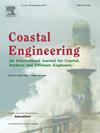Developing a decision tree model to forecast runup and assess uncertainty in empirical formulations
IF 4.2
2区 工程技术
Q1 ENGINEERING, CIVIL
引用次数: 0
Abstract
The coastal zone is a dynamic region that can change rapidly and significantly with respect to the morphology of the beach and incoming wave conditions. Runup forecasts may be improved by adapting a dynamic approach that allows for different runup models to be implemented in response to changes in beach state. Accurately forecasting wave runup is critical to characterize exposure to coastal hazards and provide an early warning against potential erosion and inundation. Here, we developed a decision tree model to produce a weighted ensemble of existing runup models to predict 1.25 years of runup at Duck, North Carolina, USA. We then applied the calibrated decision tree model to reproduce observed runup during the DUNEX experiment in Pea Island, North Carolina, USA. We found that the decision tree approach yielded a prediction that was comparable or greater in accuracy (i.e. higher r2, lower RMSE) than the individual runup models. We also interrogated the decision tree predictions to determine how the individual models perform relative to each other and why certain models perform better than others under the same observed wave and beach conditions. We found that the decision tree approach drew on the processes represented in the individual models in the ensemble to produce a forecast that is accurate and explainable without relying on prior knowledge of the study site(s) or requiring manual adjustments beyond the initial model training.
开发决策树模型以预测运行和评估经验公式的不确定性
沿岸带是一个动态区域,会因海滩形态和海浪条件的变化而迅速发生重大变化。通过采用动态方法,可以根据海滩状态的变化采用不同的径流模式,从而改进径流预报。准确预报波浪上升对确定海岸灾害的暴露特征以及对潜在的侵蚀和淹没提供早期预警至关重要。在这里,我们开发了一个决策树模型,对现有的径流模型进行加权组合,以预测美国北卡罗来纳州达克 1.25 年的径流。然后,我们将校准后的决策树模型用于再现美国北卡罗来纳州豌豆岛 DUNEX 试验期间观测到的径流。我们发现,与单个径流模型相比,决策树方法得出的预测精度相当或更高(即 r2 较高、RMSE 较低)。我们还对决策树预测进行了分析,以确定各个模型之间的相对性能,以及在相同的观测波浪和海滩条件下,某些模型比其他模型性能更好的原因。我们发现,决策树方法借鉴了集合中单个模型所代表的过程,产生了准确且可解释的预测结果,而无需依赖研究地点的先验知识,也无需在初始模型训练之外进行人工调整。
本文章由计算机程序翻译,如有差异,请以英文原文为准。
求助全文
约1分钟内获得全文
求助全文
来源期刊

Coastal Engineering
工程技术-工程:大洋
CiteScore
9.20
自引率
13.60%
发文量
0
审稿时长
3.5 months
期刊介绍:
Coastal Engineering is an international medium for coastal engineers and scientists. Combining practical applications with modern technological and scientific approaches, such as mathematical and numerical modelling, laboratory and field observations and experiments, it publishes fundamental studies as well as case studies on the following aspects of coastal, harbour and offshore engineering: waves, currents and sediment transport; coastal, estuarine and offshore morphology; technical and functional design of coastal and harbour structures; morphological and environmental impact of coastal, harbour and offshore structures.
 求助内容:
求助内容: 应助结果提醒方式:
应助结果提醒方式:


